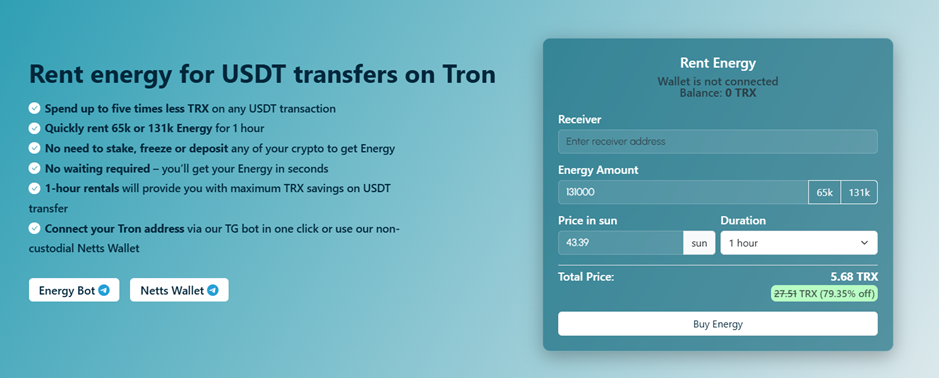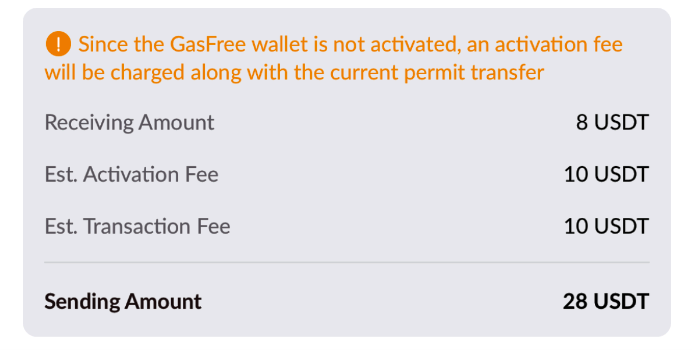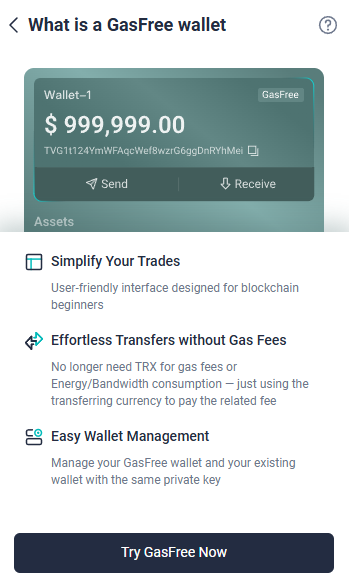Is It Possible to Send USDT to Tron Without Any Fees at All?
The USDT stablecoin, like other TRC-20 tokens, is a smart contract. When transferring USDT TRC-20 (before the GasFree feature appeared on the Tron blockchain), the transaction fee could be paid in the following ways:
- native currency TRX, as on most other cryptocurrency blockchains;
- special resources that are specifically created for Tron users – Energy and Bandwidth;
- combined approach – TRX+Energy+Bandwidth.
Depending on the recipient's balance, one transaction when transferring USDT costs the sender 13.4 or 27 TRX.
And if the user pays for gas in full with rented Energy, then the costs for the entire process are ~3-6 TRX. This is the amount that will be withdrawn from the deposit when renting 65K or 131K Energy units, respectively, through the NETTS service. Here is an example of a completed form – in this case, the tenant receives 131K Energy units for 1-hour rental.

The appearance of GasFree technology in the Tron blockchain was preceded by a promise to completely free users from paying for gas. But is this really the best solution, or is renting Energy still a more profitable option? There is no need to write much to answer this question – just look at another screenshot and compare it with the previous one.

Even without taking into account the one-time fee for activating a special wallet, 10 USDT for transferring any amount (here – for 8 USDT) is not efficient at all.
First, let’s discuss GasFree technology, which allows you to send USDT without paying for gas. We explain why GasFree option is not as efficient compared to renting Energy and consider the pros and cons of both approaches to paying transaction fees on the Tron network.
How Does GasFree Work?
The GasFree feature, which was launched by the Tron eco-platform in early March, allows you to send USDT TRC-20 without having to hold TRX or special Energy and Bandwidth resources on your balance.
When using this method, the commission for gas in TRX or Energy and Bandwidth is paid by the service provider (smart contract sponsor) instead of the user.
That is, when using the GasFree feature, a standard transaction is complicated, becoming a meta-transaction. This allows the sender of USDT to perform actions in the Tron ecosystem without directly paying a gas fee each time.
Instead, a third party pays the gas fee, in our case it could be a service provider or another smart contract sponsor. The sender signs the transaction and the provider processes it and pays for the gas.
But for the Tron network user, of course, this transaction is not free at all. Although this is how it was presented to the crypto community by the media last year. In fact, the user is obliged to pay this cost, just in stablecoins.
And compared to paying for gas in TRX, it turns out to be more expensive, and compared to paying for a transaction with rented Energy, it is significantly more expensive.
GasFree Benefits
Of course, this approach also has its advantages, in particular:
- simplicity for users who rarely use Tron;
- the ability to send USDT even if there is 0 TRX on the balance and no resource reserve.

Disadvantages of GasFree
The disadvantages of this method of paying commissions are hidden in its advantages:
- GasFree is a very narrowly focused mechanism, its users are either Tron newbies who have not yet mastered the most effective mechanisms of the blockchain, or holders of large funds for whom shelling out 10-20 USDT for the transfer of 10-100 thousand stablecoins is an insignificant expense in exchange for the absence of hassle.
- The service provider may include hidden fees or restrictions.
- This function is not supported by all wallets and services.
- When the network is heavily loaded, the provider may limit the number of meta-transactions.
To sum it up: the GasFree function is in demand by a narrow circle of users.
Those who regularly transfer USDT TRC-20 are not ready to pay 10-20 USDT for one transaction regardless of the transfer amount.
Beginner users usually do not have enough USDT on their balance to pay fees with it.
Energy rental market is growing – after all, this is the most profitable way to pay for gas, truly excluding TRX from the commission.
Why Might Renting Energy Be Better?
Using special resources to pay for gas is the exclusive prerogative of Tron blockchain users. Initially, this resource could only be obtained by staking. Unlike the Bandwidth resource, which appears on the balance of each blockchain participant daily and for free. Today, it is 600 units. This resource is used to pay for gas when transferring TRC-10. But for a transaction with TRC-20 standard tokens, you also need to have 345 Bandwidth units for one USDT transfer.
Energy staking requires a significant amount of TRX to be withdrawn from circulation for half a month. If this option is not available, the user is left without Energy and has to pay for gas with native crypto, which is very unprofitable.
The problem of a lack of TRX for staking or resources for paying for gas is successfully solved by renting Energy through special services.
The example above confirms that renting Energy is a proven way to really refuse to pay for gas. The Energy rental service will do it for you NETTS. You will simply pay for the service of charging your wallet with Energy in the amount necessary for the successful transfer of USDT.
3-6 TRX is not expensive at all for such a level of comfort. Especially compared to 10 USDT that you will have to pay for the comfort of GasFree. And with automatic recharge via Telegram Energy Bot you can save some of the resources spent in case of non-use of rented Energy. You can also use the Workspace web interface for full automation of resource replenishment at the lowest price around the clock.

Of course, NETTS is currently the only service that allows you to reduce the cost of transferring TRC-20 by 80%. But the Energy rental market is steadily growing, as it is ideal for those who regularly and frequently send USDT and other TRC-20 tokens.
Benefits of Energy Rental
Energy leasing is the ideal option today to significantly reduce transaction costs. It provides the following benefits to a Tron user who regularly interacts with TRC-20 tokens:
- fixed low price, set by the rental service;
- predictable expenses;
- variability in the choice of payment – deposit or prepayment;
- rented Energy can be used not only for USDT transfers, but also for any TRC-20 transactions, including DApps;
- Energy rental is available for all wallets that support Tron.
Some services also offer their own wallets that are compatible with the Tron blockchain.
Disadvantages of Energy Rental
The only disadvantage of this method is the need to carefully calculate the required amount of Energy in advance.
But the Energy rental service NETTS is ready to provide additional comfort here too. You can return the excess volume of unused resource without payment if you have a deposit. It can be replenished through Netts Energy Bot. It's only 15 TRX, but you won't have to calculate the required volume with the fear of overpaying for the extra. NETTS will simply withdraw from the deposit the cost of Energy actually used for the transaction.
Some consider the need to have a small reserve of TRX on the balance for prepaid rent a disadvantage – NETTS provides the ability to pay for services in stablecoins.
GasFree vs. Energy Rental: Which is More Profitable?
Let's compare both methods by key parameters:
| Parameter | GasFree | Energy rental |
|---|---|---|
| Availability of native TRX crypto | No | No – you can find a service that accepts USDT for services |
| Fixed commission | Not always – depends on the provider's policy | Yes |
| Interact with any TRC-20 tokens | No | Yes |
| Support in other wallets | No | Yes |
| Suitable for bulk transactions | No | Yes |
| Transaction cost when transferring USDT TRC-20 at one address | 10 USDT | 3-6 TRX (depending on the recipient's USDT availability) |
Conclusion: If you need to send USDT without the ability to top up your TRX or Energy balance, GasFree can be useful, but the transaction will be much more expensive than using rented Energy.
If you make frequent transactions, renting Energy is pretty much the only optimal choice, as it offers stable low fees.
There is a surefire way to save your USDT and TRX – switch to rented Energy. With the NETTS Energy rental service, you get three times more transactions for the same investment when compared to staking!